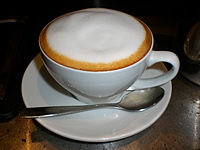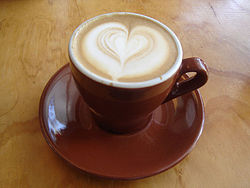- Cappuccino
-
For other uses, see Cappuccino (disambiguation).
A cappuccino (Italian pronunciation: [kapːutˈtʃiːno], English pronunciation: /kæpəˈtʃiːnoʊ/, meaning "Capuchin" or literally "small cap") is an Italian coffee drink prepared with espresso, hot milk, and steamed-milk foam. The name comes from the Capuchin friars, referring to the colour of their habits.[1]
Contents
Definition
A cappuccino is a coffee drink topped with micro-foamed milk. It is made in a steam-producing espresso machine. Espresso is poured into the bottom third of the cup, and is followed by a similar amount of hot milk. The top third of the drink consists of milk foam; this foam is often decorated with artistic drawings made with the same milk called latte art. Shaved chocolate, raw sugar, cinnamon, or other spices are often sprinkled onto the top of the finished drink. Cappuccinos are served with a teaspoon and then consumed.
In a traditional cappuccino, as served in Europe and artisan coffee houses in the United States, the total of espresso and milk/foam make up between approximately 150–180 mL (5–6 imp fl oz; 5–6 US fl oz). Commercial coffee chains in the US more often serve the cappuccino as a 360 mL (13 imp fl oz; 12 US fl oz) drink or larger.[2]
History
Espresso machines of the type used to make cappuccino were introduced at the beginning of the 20th century when Luigi Bezzera of Milan filed the first patent in 1901.[3] Cappuccino was developed in Italy by the early 1900s, and grew in popularity as the large espresso machines in cafés and restaurants were improved during and after World War II, specifically with the introduction of the modern, high-pressure espresso machine by Italian company Gaggia in 1948. The beverage had developed into its current form by the 1950s.
In the United Kingdom, espresso coffee initially gained popularity in the form of the cappuccino, due to the British custom of drinking coffee with milk, the desire for a longer drink so the café may serve as a destination, and the exotic texture of the beverage.[4]
Ingredients
Besides a shot of espresso, the most important factor in preparing a cappuccino is the texture and temperature of the milk. When a barista steams the milk for a cappuccino, microfoam is created by introducing very tiny bubbles of air into the milk, giving the milk a velvety texture. The traditional cappuccino consists of an espresso, on which the barista pours the hot foamed milk, resulting in a 2 cm (¾ inch) thick milk foam on top. Variations of the mixtures are usually called cappuccino chiaro (white cappuccino, also known as a wet cappuccino) with more milk than normal, and cappuccino scuro (dark cappuccino, also known as a dry cappuccino) with less steamed milk than normal.
Attaining the correct ratio of foam requires close attention while steaming the milk, thus making the cappuccino one of the most difficult espresso-based beverages to make properly. A skilled barista may obtain artistic shapes while pouring the milk on the top of the espresso coffee.[2]
Popularity
Cappuccino was traditionally a taste largely appreciated in Europe, Australia, South America and some of North America. By the mid-1990s cappuccino was made much more widely available to North Americans, as upscale coffee houses sprang up.
In Italy, and throughout continental Europe, cappuccino was traditionally consumed early in the day as part of the breakfast, with some kind of sweet pastry. Generally, Europeans did not drink cappuccino with meals other than breakfast, preferring espresso throughout the day and following dinner. However, in recent years Europeans have started to drink cappuccino throughout the entire day. Especially in western-Europe (The UK, Ireland, The Netherlands, Germany, Belgium) cappuccino is popular at cafés and terraces during the afternoon and in restaurants after dinner. In the United States, cappuccinos have become popular concurrent with the boom in the American coffee industry through the late 1990s and early 2000s, especially in the urban Pacific Northwest.[5]
Iced cappuccino
Cappuccino Freddo is the cold version of a cappuccino, where the drink usually has a small amount of cold frothed milk atop it. This drink is widely available in parts of Italy. In Rome, for example, each bar has the drink already prepared. In cities of Northern Italy, like Milan, however, it is almost impossible to find cappuccino freddo. Instead, "gelato da bere" (a thick blend of gelato and espresso) or "shakerato" (espresso and ice shaken together) are more popular. The term has also spread throughout the Mediterranean region where foam is added to the drink just before serving, often varying from the Italian original. In North America, however, the terms "Cappuccino Freddo" or "Iced cappuccino", if offered, may be somewhat of a misnomer if the characteristic frothed milk is omitted in the iced variation. For example, at Starbucks, without the frothed milk the drink is called an "iced latte". Since it is possible to froth cold milk using various methods, Starbucks now makes a cold cappuccino called "Iced Cocoa Cappuccino".[6]
By the start of the 21st century, a modified version of cappuccino was being served by fast-food chains, offering sizes up to 600 ml (21 imp fl oz; 20 US fl oz). In recent years leading independent cafés have begun offering cappuccino in its traditional size (150–180 ml (5–6 imp fl oz; 5–6 US fl oz)) only - distinguishing them from other cafés and larger chains.[6] Starbucks does offer a "short" cappuccino (240 ml (8 imp fl oz; 8 US fl oz)), but it is not listed on store menus or on its website.[6]
Convenience store cappuccino
The widespread acceptance of the cappuccino led to many establishments, such as convenience stores, offering a product labeled as "cappuccino" to their patrons. However, that product is usually produced by machines similar to those that mix cocoa drinks, and made with either a manufactured mix or double-brewed coffee. The resulting beverage is unlike regular cappuccino. Convenience-store cappuccino is typically produced in a high-speed cyclonic mixing chamber, using preheated water stored in the machine. When activated, the whipping impeller begins spinning, and dry powder mix and water are introduced into the chamber, with the strength of the final product controlled by how quickly the powder is fed into the mix chamber. Foam is a natural byproduct of the process. Some machines also inject a liquid flavor concentrate stored in small disposable pouches, allowing a single mix chamber to produce flavor variations such as mocha or vanilla. Because all supplies are either dry powder or in aseptic disposable packaging, these systems are very low maintenance, requiring only cleaning of the mix chamber and impeller. To further reduce maintenance, when the operator releases the fill button, most machines continue to run without powder for a few moments to flush the mix chamber with clear water.
Additionally, store-bought mixes intended for home use are also produced. These powders are intended to be mixed with hot water or milk, an attempt to produce a beverage comparable to that found in convenience stores; these are often advertised as "frothed coffee."
Similar drinks
Other milk and espresso drinks similar to the cappuccino include:
- Caffè macchiato – sometimes called espresso macchiato, is a coffee drink, made out of espresso with a small amount of milk; shorter than a cappuccino (Not a small amount of milk 'stained' with espresso)
- Latte – (short for "caffè-latte") longer drink, with more milk, amount of foam varies
- Babyccino – a cappuccino without coffee (i.e. hot milk topped with foamed milk) made for young children. Often sprinkled with chocolate.
References
- ^ The Culture of Italian Coffee
- ^ a b "Cappuccino". BuyCappuccinoMachine.net. http://buycappuccinomachine.net/cappuccino. Retrieved August 7, 2011.
- ^ An Espresso Timeline timelineindex.com
- ^ (Morris 2007)
- ^ http://blog.gourmet-coffee-zone.com/2008/03/07/the-pacific-northwest-coffee-culture-central
- ^ a b c "Iced Cappuccino". BuyCappuccinoMachine.net. http://buycappuccinomachine.net/iced-cappuccino/. Retrieved July 26, 2011.
External links
- Coffeegeek with how-to steam guide
- Italian Espresso National Institute
- International Institute of Coffee Tasters
- Coffee Taster, the free newsletter of the International Institute of Coffee Tasters, featuring articles on the quality of espresso, chemical and sensory analysis, market trends
- Morris, Jonathan (2007), The Cappuccino Conquests. The Transnational History of Italian Coffee, http://www.cappuccinoconquests.org.uk/assets/project-report.pdf, website, summar
Coffee Topics - Economics
- Fair trade
- Health effects
- History
Production by
countrySpecies and
varietiesMajor
componentsProcessing Preparation Popular
beverages- Affogato
- Americano
- Bicerin
- Cà phê sữa đá
- Café au lait
- Café con leche
- Café Cubano
- Cafe mocha
- Caffè corretto
- Caffè macchiato
- Cappuccino
- Carajillo
- Coffee milk
- Cortado
- Espresso
- Flat white
- Frappuccino
- Galão
- Greek frappé coffee
- Iced coffee
- Indian filter coffee
- Ipoh white coffee
- Irish coffee
- Kopi Luwak
- Latte
- Latte macchiato
- Liqueur coffee
- Long black
- Red eye
- Ristretto
- Turkish coffee
Substitutes Lifestyle Categories:- Italian beverages
- Italian cuisine
- Italian loanwords
- Coffee beverages
Wikimedia Foundation. 2010.


